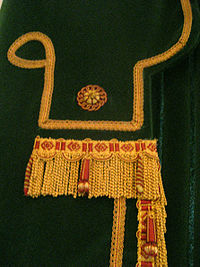AFringeis an ornamentaltextile trimapplied to an edge of atextileitem, such asdrapery,aflag,orepaulettes.


Fringe originated as a way of preventing a cut piece offabricfrom unraveling when ahemmingwas not used. Several strands ofweftthreads would be removed, and the remaining warp threads would be twisted or braided together to prevent unraveling. In modern fabrics, fringe is more commonly made separately and sewn on. Modern "add-on" fringe may consist ofwool,silk,linen,or narrow strips ofleather.The use of fringe is ancient, and early fringes were generally made of unspun wool (rather than spun or twisted threads).[1]
There are many types of fringe. Particularly in Western Europe, as wealth and luxury items proliferated duringthe Renaissance,types of fringe began to assume commonly accepted names. Styles of fringes were clearly defined inEnglandby at least 1688.[1]
Types of fringe include:
- Bullion fringe,is a twisted yarn which generally contains threads ofsilverorgold.[1]The name derives from bullionhose,which had a twisted element at the top that resembled this type of fringe.[1]Modern bullion fringe varies widely in texture and width, but generally is only 3 to 9 inches (7.6 to 22.9 cm) in length.[2]
- Campaign fringe,from theFrenchwordcampane(meaning "bell" ), consists of small, bell-liketasselson the end.[1]
- Thread fringe,untwisted and unbraided loose warp threads.[1]
References
edit- ^abcdefCooke, Edward S. (1987).Upholstery in America & Europe: From the Seventeenth Century to World War I.New York: Norton. p. 133.ISBN9780393024692.
- ^Hasting, Pamela (2002).Simple-to-Sew Slipcovers and Cover-Ups.New York: Sterling Publishing Company. p. 19.ISBN9781402700767.
Further reading
edit- Pegler, Martin M.The Dictionary of Interior Design.Fairchild Publications:1983.ISBN9780870054471